August 16, 2007
Reflections on Ukraine trip (with Munich stopover). Carolyn and I did a cruise from Kiev to Yalta in 2007. It was a scary look at what might have happened had my ancestors NOT escaped from the bloodlands. Our last night in Kiev, I had a cigar and the talk I should have had with my father when he was alive, 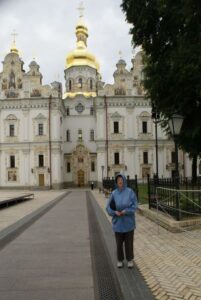
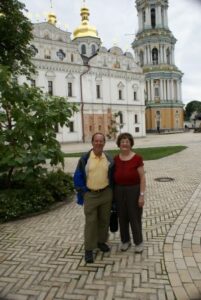 thanking him for coming to the United States, or rather for escaping.
thanking him for coming to the United States, or rather for escaping.
Our English group onboard consisted of African expats, another US couple, a Canadian couple, and a Dutch couple (who didn’t want to be part of the German-speaking group). Our discussion frequently centered on “where does Europe stop and Asia begin?” Eastern Europe and Russia are certainly moot on that question.
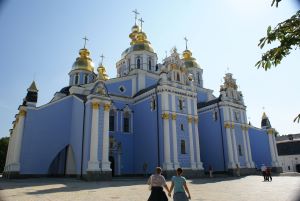
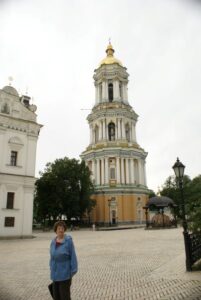 We got into Kiev early so we could explore on our own, particularly the stunning monasteries, dating back (at least the Monastery of the Caves) to 1051. Others included Pechersk Lavra (1688), St. Sophia, and St. Michael’s Golden Dome.
We got into Kiev early so we could explore on our own, particularly the stunning monasteries, dating back (at least the Monastery of the Caves) to 1051. Others included Pechersk Lavra (1688), St. Sophia, and St. Michael’s Golden Dome.
The trip included a lot of looks at traditional life in the countryside, with a lot of meals and folk dances. Much of the fare 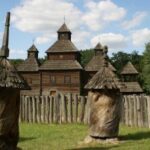
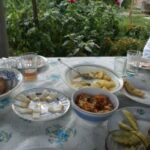 resembles what my Ukrainian Jewish relatives ate: except for the salo (pork). The borscht and vodka were familiar. Surprisingly, statues of Lenin were very much in evidence.
resembles what my Ukrainian Jewish relatives ate: except for the salo (pork). The borscht and vodka were familiar. Surprisingly, statues of Lenin were very much in evidence.
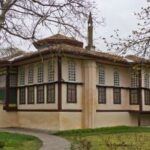
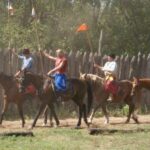 The trip included some sights that are no longer on the Kiev itinerary: Sevastopol (now part of Russia again; it was strange seeing the Russian fleet headquartered in Ukraine), the Crimea (with its Tatar remnants), and Yalta.
The trip included some sights that are no longer on the Kiev itinerary: Sevastopol (now part of Russia again; it was strange seeing the Russian fleet headquartered in Ukraine), the Crimea (with its Tatar remnants), and Yalta.
Catherine the Great was important in the southward movement of Russia into the Ukraine, creating new cities or moving German farmers to the Russian frontier to stave off the Tatars and the Turks. This was after all a battleground for several hundred years as Russia sought a port on the Black Sea, with dreams of creating a Russian new Rome in Istanbul. One of the groups of warriors who aided Catherine were the dreaded Cossacks, whose pogroms led my grandparents to seek refuge in the United States.
The Crimea included a look at the Khanate of Bakhchisaray, which was a stronghold for the Tatars (who were forcibly removed during World War II to central Asia). We got to the battlefield which inspired the poem, “Half a league…into the Valley of Death.” Not much to see there.
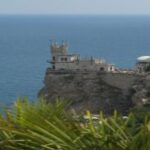
Yalta provided a connection to World War II and its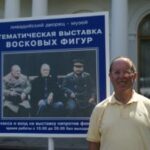 aftermath. The Big 3 meeting there helped decide the fate of Europe, particularly Eastern Europe. Its pleasant climate makes it a vacation spot, as it was for Nicholas II, whose Livadia Palace played host to Stalin, Churchill, and Roosevelt.
aftermath. The Big 3 meeting there helped decide the fate of Europe, particularly Eastern Europe. Its pleasant climate makes it a vacation spot, as it was for Nicholas II, whose Livadia Palace played host to Stalin, Churchill, and Roosevelt.
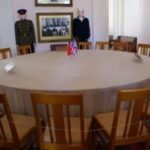
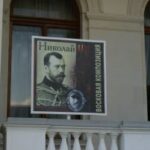 The trip ended at Odessa, a cosmopolitan city with at one time a thriving Jewish population. The most famous site is, of course, the stairs which Eisenstein popularized in the movie, Battleship Potemkin. In World War II, Germany promised it to the Romanians to get
The trip ended at Odessa, a cosmopolitan city with at one time a thriving Jewish population. The most famous site is, of course, the stairs which Eisenstein popularized in the movie, Battleship Potemkin. In World War II, Germany promised it to the Romanians to get 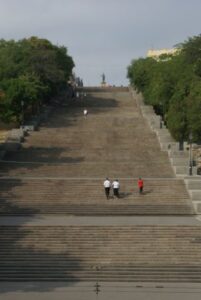
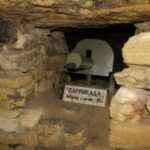 them to join the Axis (and supply oil from Ploesti to fuel the war machine). There were interesting caves for guerilla warfare, but the theme of the second world war dominated other parts of the trip as well. Much of Ukraine was rebuilt using German prisoner labor after World War II. In ugly Russian fashion.
them to join the Axis (and supply oil from Ploesti to fuel the war machine). There were interesting caves for guerilla warfare, but the theme of the second world war dominated other parts of the trip as well. Much of Ukraine was rebuilt using German prisoner labor after World War II. In ugly Russian fashion.
I knew I’d have to go back later to Lvov and the western part of the country. Glad I did it before Russia got imperialistic and attacked.
Odessa definitely worth a trip just for the stairs in the Battleship Potemkin, and Yalta for its connection to World War II and its aftermath. The Big 3 meeting here helped decide the fate of Europe, particularly Eastern Europe.
Here was my summary when I returned:
Just back from Ukraine. No internet, so no stories, but here’s a few at the time:
Re: Service standards–
I asked at the hotel (4 star) for help in finding a Scout shop. They gave me a (Cyrillic) phone book.
Re: My dad
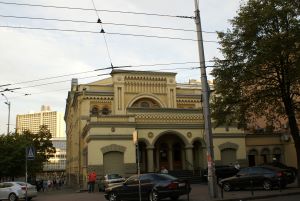
Carolyn suggested a Jewish restaurant (and I discovered that a lot of “Eastern European” food–and music for that matter, is likely to be consumed in Jewish households). We met a couple (Jewish) who’d left in 1979. When I pointed out that my dad had left in 1913, they said he chose a better time than they did.
Re: Genocide
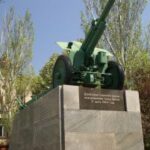 It’s hard for Americans (though maybe possible for Southerners) to think about war being against non-combatants, but for Europeans (the tribes!) cities and civilians died for centuries. In WWII, many of the Ukraine cities took it on the chin, with 6 million dead (Stalin probably killed 2 million of them!) and cities 97% destroyed. The consolation, if there is one, is that over time, almost every one of the European tribes got to do unto others as others had done unto them.
It’s hard for Americans (though maybe possible for Southerners) to think about war being against non-combatants, but for Europeans (the tribes!) cities and civilians died for centuries. In WWII, many of the Ukraine cities took it on the chin, with 6 million dead (Stalin probably killed 2 million of them!) and cities 97% destroyed. The consolation, if there is one, is that over time, almost every one of the European tribes got to do unto others as others had done unto them.
Re: The cold war
The Black Sea Fleets (Russian and Ukrainian) are quartered in Sevastopol. We went to a concert of the Russian Black Sea Fleet where they sang Fiddler on the Roof and sold CDs (probably because they are not being paid by Russia).
Re: who won WWII?
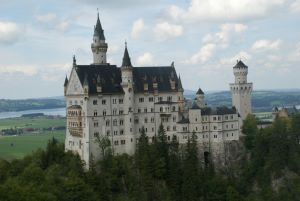
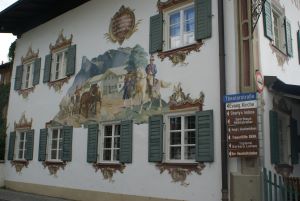 We came back through Munich and spent a few days there. As we walked through Munich (which was also been wiped out in WWII) and looked and compared the East with the West, I couldn’t help but ask the question. The German city was immaculate, and the countryside looked like a postcard. Of course, Neuschwanstein Castle of Mad Ludwig stood out; it was the prototype for Disney’s magic castle. Bavaria has its own dialect and was semi-independent under the German Confederation, issuing its own stamps until the end of World War I.
We came back through Munich and spent a few days there. As we walked through Munich (which was also been wiped out in WWII) and looked and compared the East with the West, I couldn’t help but ask the question. The German city was immaculate, and the countryside looked like a postcard. Of course, Neuschwanstein Castle of Mad Ludwig stood out; it was the prototype for Disney’s magic castle. Bavaria has its own dialect and was semi-independent under the German Confederation, issuing its own stamps until the end of World War I.
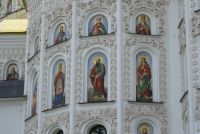
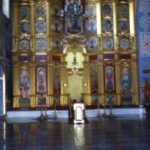 Reminiscences 2025
Reminiscences 2025